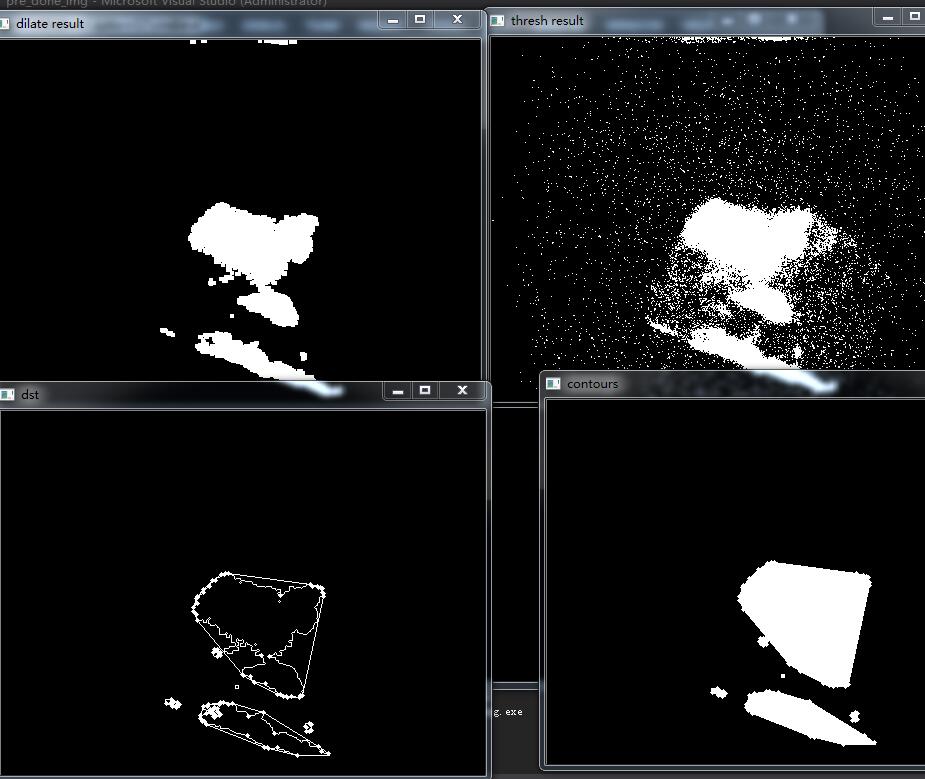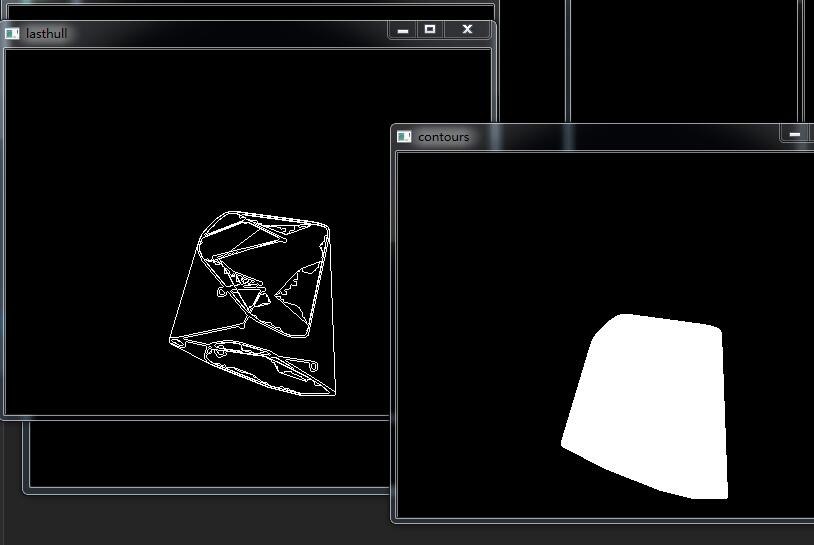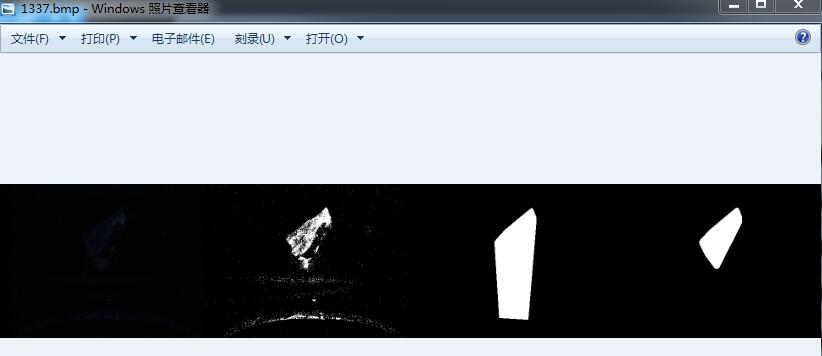將多個凸包連線起來形成一個大凸包找到最接近的輪廓
阿新 • • 發佈:2019-01-25
目的:對於很暗很暗的影象 用普通方法不好一下找到輪廓 現在需要找到其最接近的輪廓

拿一種一張圖的中間結果來說:#include<opencv2/opencv.hpp> #include<opencv2/imgproc/imgproc.hpp> #include<opencv2/highgui/highgui.hpp> #include <afxwin.h> #include<fstream> using namespace std; using namespace cv; Mat my_contour(IplImage* dst, IplImage bimgipl) { cvZero(dst); CvMemStorage *storage = cvCreateMemStorage(); CvSeq *contour = NULL, *hull = NULL; vector<CvPoint> allpoints; CvContourScanner scanner = cvStartFindContours(&bimgipl, storage); while ((contour = cvFindNextContour(scanner)) != NULL) { cvDrawContours(dst, contour, cv::Scalar(255), cv::Scalar(255), 0); hull = cvConvexHull2(contour, 0, CV_CLOCKWISE, 0); CvPoint pt0 = **(CvPoint**)cvGetSeqElem(hull, hull->total - 1); allpoints.push_back(pt0); for (int i = 0; i < hull->total; ++i) { CvPoint pt1 = **(CvPoint**)cvGetSeqElem(hull, i); allpoints.push_back(pt1); cvLine(dst, pt0, pt1, cv::Scalar(255)); pt0 = pt1; } } //上面是第一次尋找 可能找到了多個輪廓即有多個凸包 下面儲存每個凸包的凸點到容器中 然後將這些點連線起來 這樣就有凹陷的地方了 就可以在此基礎上尋找最後的凸包了 Mat dstmat(dst, 0); std::vector<std::vector<cv::Point>> myown_contours; cv::findContours(dstmat, myown_contours, CV_RETR_EXTERNAL, CV_CHAIN_APPROX_NONE); //判斷也許本來就只有一個凸包 就不用存點畫線再尋一次凸包了 if (myown_contours.size() > 1) { for (int i = 0; i < allpoints.size() - 1; i++) { CvPoint firstdot = allpoints[i]; CvPoint secdot = allpoints[i + 1]; cvLine(dst, firstdot, secdot, cv::Scalar(255), 2); } CvContourScanner scanner2 = cvStartFindContours(dst, storage); while ((contour = cvFindNextContour(scanner2)) != NULL) { cvDrawContours(dst, contour, cv::Scalar(255), cv::Scalar(255), 0); hull = cvConvexHull2(contour, 0, CV_CLOCKWISE, 0); CvPoint pt0 = **(CvPoint**)cvGetSeqElem(hull, hull->total - 1); for (int i = 0; i < hull->total; ++i) { CvPoint pt1 = **(CvPoint**)cvGetSeqElem(hull, i); cvLine(dst, pt0, pt1, cv::Scalar(255)); pt0 = pt1; } } } Mat bimgdst(dst, 0); std::vector<std::vector<cv::Point>> contours; cv::findContours(bimgdst, contours, CV_RETR_EXTERNAL, CV_CHAIN_APPROX_NONE); Mat contoursimg(bimgdst.size(), CV_8UC1, cv::Scalar(0)); drawContours(contoursimg, contours, -1, Scalar(255), CV_FILLED); return contoursimg; } char filename[100]; char savename[100]; void main() { TickMeter tm; tm.start(); vector<Mat> bgrimgs; for (int i = 1; i <= 1657; i++) { sprintf(filename, "正常圖_壓縮\\%d.bmp", i); sprintf(savename, "my_result3\\%d.bmp", i); Mat img = imread(filename); // split(img, bgrimgs); Mat bimg(img.size(), CV_8UC1, cv::Scalar(0)); bgrimgs[0].copyTo(bimg); // threshold(bimg, bimg, 12, 255, CV_THRESH_BINARY/*|CV_THRESH_OTSU*/); //imshow("thresh result", bimg); // Mat element(4, 4, CV_8U, cv::Scalar(1)); morphologyEx(bimg, bimg, cv::MORPH_OPEN, element); //imshow("dilate result", bimg); //前20行置0 去除上部分的水滴噪聲 後20行也置0 去除下面的噪聲 /* //這個置0沒有下面寫的置0好 用下面的 IplImage bimgipl = bimg; cvSetImageROI(&bimgipl, cvRect(0, 0, bimg.size().width,20)); IplImage* bimg_front = cvCreateImage(cvSize(bimg.size().width, 20), IPL_DEPTH_8U, 1); cvCopy(&bimgipl, bimg_front, 0); cvShowImage("front", bimg_front); cvSetImageROI(&bimgipl, cvRect(0, bimg.size().height-20, bimg.size().width, 20)); IplImage* bimg_end = cvCreateImage(cvSize(bimg.size().width, 20), IPL_DEPTH_8U, 1); cvCopy(&bimgipl, bimg_end, 0); cvShowImage("end", bimg_end); cvZero(bimg_front); cvZero(bimg_end); */ for (int i = 0; i < 20; i++) { uchar* data = bimg.ptr<uchar>(i); for (int j = 0; j < bimg.size().width; j++) data[j] = 0; } for (int i = bimg.size().height - 19; i < bimg.size().height; i++) { uchar* data = bimg.ptr<uchar>(i); for (int j = 0; j < bimg.size().width; j++) data[j] = 0; } //凸包找輪廓 (我用了2次凸包 中間用線連線 方便第二次凸包 找到完整輪廓) IplImage mybimgipl = bimg; IplImage *mydst = cvCreateImage(cvGetSize(&mybimgipl), 8, 1); Mat myresult(mydst, 0); myresult = my_contour(mydst, mybimgipl); imwrite(savename, myresult); } tm.stop(); cout << "count=" << tm.getCounter() << ",process time=" << tm.getTimeMilli() << " ms" << endl; }


done!!!!今天星期五!好開心!!!!!!!!!!!!
關於opencv中找輪廓的 : http://www.cnblogs.com/nktblog/p/4027137.html 寫得很棒
////////////////////////////////
給學校我自習室的電腦上裝了opencv2.4.13 按照http://blog.csdn.net/dcrmg/article/details/51809614

//////////////////////////////////////////////////////////////////////////////////////////////////
我公司的同事說我這個比較慢 他在網上 https://github.com/abatilo/QuickHull 找到一個快速找凸包的叫我應用進來:於是我重新又寫了個:
#include <algorithm> #include <cmath> #include <vector> #include <chrono> #include <cstdio> #include <random> #include <vector> #include<opencv2/opencv.hpp> #include<opencv2/imgproc/imgproc.hpp> #include<opencv2/highgui/highgui.hpp> using namespace std; using namespace cv; struct myPoint { int x; int y; bool operator<(const myPoint& pt) { if (x == pt.x) { return (y < pt.y); } return (x < pt.x); } }; // http://stackoverflow.com/questions/1560492/how-to-tell-whether-a-myPoint-is-to-the-right-or-left-side-of-a-line // A and B are used to define a line // C is the myPoint whose side we're trying to determine int SideOfLine(const myPoint &P1, const myPoint &P2, const myPoint &P3) { return (P2.x - P1.x) * (P3.y - P1.y) - (P2.y - P1.y) * (P3.x - P1.x); } // https://en.wikipedia.org/wiki/Distance_from_a_myPoint_to_a_line#Line_defined_by_two_myPoints float DistanceFromLine(const myPoint &P1, const myPoint &P2, const myPoint &P3) { return (std::abs((P2.y - P1.y) * P3.x - (P2.x - P1.x) * P3.y + P2.x * P1.y - P2.y * P1.x) / std::sqrt((P2.y - P1.y) * (P2.y - P1.y) + (P2.x - P1.x) * (P2.x - P1.x))); } // http://stackoverflow.com/questions/13300904/determine-whether-myPoint-lies-inside-triangle bool myPointInTriangle(const myPoint &p, const myPoint &p1, const myPoint &p2, const myPoint &p3) { float a = ((p2.y - p3.y) * (p.x - p3.x) + (p3.x - p2.x) * (p.y - p3.y)) / ((p2.y - p3.y) * (p1.x - p3.x) + (p3.x - p2.x) * (p1.y - p3.y)); float b = ((p3.y - p1.y) * (p.x - p3.x) + (p1.x - p3.x) * (p.y - p3.y)) / ((p2.y - p3.y) * (p1.x - p3.x) + (p3.x - p2.x) * (p1.y - p3.y)); float c = 1.0f - a - b; return (0.0f < a && 0.0f < b && 0.0f < c); } // http://www.cse.yorku.ca/~aaw/Hang/quick_hull/Algorithm.html void FindHull(const std::vector<myPoint> &Sk, const myPoint P, const myPoint Q, std::vector<myPoint> &hullmyPoints) { // If Sk has no myPoint, then return if (Sk.size() == 0) return; std::vector<myPoint> S0; std::vector<myPoint> S1; std::vector<myPoint> S2; // From the given set of myPoints in Sk, find farthest myPoint, say C, from segment PQ float furthestDistance = 0.0f; myPoint C; for (const auto &pt : Sk) { float distance = DistanceFromLine(P, Q, pt); if (distance > furthestDistance) { furthestDistance = distance; C = pt; } } // Add myPoint C to convex hull at the location between P and Q hullmyPoints.push_back(C); /* * Three myPoints P, Q, and C partition the remaining myPoints of Sk into 3 subsets: S0, S1, and S2 * where S0 are myPoints inside triangle PCQ, S1are myPoints on the right side of the oriented * line from P to C, and S2 are myPoints on the right side of the oriented line from C to Q. */ for (const auto &pt : Sk) { if (myPointInTriangle(pt, P, C, Q)) { S0.push_back(pt); } else if (0 < SideOfLine(P, C, pt)) { S1.push_back(pt); } else if (0 < SideOfLine(C, Q, pt)) { S2.push_back(pt); } } FindHull(S1, P, C, hullmyPoints); FindHull(S2, C, Q, hullmyPoints); } // http://www.cse.yorku.ca/~aaw/Hang/quick_hull/Algorithm.html void QuickHull(const std::vector<myPoint> &s, std::vector<myPoint> &hullmyPoints) { // Find left and right most myPoints, say A & B, and add A & B to convex hull myPoint A = s[0]; myPoint B = s[s.size() - 1]; hullmyPoints.push_back(A); hullmyPoints.push_back(B); std::vector<myPoint> S1; std::vector<myPoint> S2; /* * Segment AB divides the remaining (n-2) myPoints into 2 groups S1 and S2 * where S1 are myPoints in S that are on the right side of the oriented line from A to B, * and S2 are myPoints in S that are on the right side of the oriented line from B to A */ for (auto it = s.begin() + 1; it != s.end() - 1; ++it) { const myPoint pt = *it; const int s1 = SideOfLine(A, B, pt); const int s2 = SideOfLine(B, A, pt); if (0 < s1) { S1.push_back(pt); } else if (0 < s2) { S2.push_back(pt); } } FindHull(S1, A, B, hullmyPoints); FindHull(S2, B, A, hullmyPoints); } Mat mypredone(IplImage* srcipl, vector<Mat> bgrimgs) { ////預處理 Mat img(srcipl, 0); split(img, bgrimgs); Mat bimg(img.size(), CV_8UC1, cv::Scalar(0)); bgrimgs[0].copyTo(bimg); threshold(bimg, bimg, 12, 255, CV_THRESH_BINARY/*|CV_THRESH_OTSU*/); Mat element(4, 4, CV_8U, cv::Scalar(1)); morphologyEx(bimg, bimg, cv::MORPH_OPEN, element); for (int i = 0; i < 20; i++) { uchar* data = bimg.ptr<uchar>(i); for (int j = 0; j < bimg.size().width; j++) data[j] = 0; } //for (int i = bimg.size().height - 19; i < bimg.size().height; i++) //{ // uchar* data = bimg.ptr<uchar>(i); // for (int j = 0; j < bimg.size().width; j++) // data[j] = 0; //} return bimg; } IplImage* luobin_findcontour(Mat bimg) { IplImage mybimgipl = bimg; CvMemStorage *storage = cvCreateMemStorage(); CvSeq *contour = NULL, *hull = NULL; vector<CvPoint> allpoints; vector<myPoint> myallpoints; CvContourScanner scanner = cvStartFindContours(&mybimgipl, storage); while ((contour = cvFindNextContour(scanner)) != NULL) { hull = cvConvexHull2(contour, 0, CV_CLOCKWISE, 0); CvPoint pt0 = **(CvPoint**)cvGetSeqElem(hull, hull->total - 1); myPoint mypt0; mypt0.x = (float)pt0.x; mypt0.y = (float)pt0.y; ////mypt0.operator<(mypt0); allpoints.push_back(pt0); myallpoints.push_back(mypt0); for (int i = 0; i < hull->total; ++i) { CvPoint pt1 = **(CvPoint**)cvGetSeqElem(hull, i); allpoints.push_back(pt1); //cvLine(mydst, pt0, pt1, cv::Scalar(255)); //pt0 = pt1; myPoint mypt1; mypt1.x = (float)pt1.x; mypt1.y = (float)pt1.y; ////mypt1.operator<(mypt1); ////////// myallpoints.push_back(mypt1); } } std::sort(myallpoints.begin(), myallpoints.end()); std::vector<myPoint> myhullPoints; QuickHull(myallpoints, myhullPoints); CvSeq *hull2 = NULL; CvSeq* ptseq = cvCreateSeq(CV_SEQ_KIND_GENERIC | CV_32SC2, sizeof(CvContour), sizeof(CvPoint), storage); for (int i = 0; i < myhullPoints.size(); ++i) { myPoint pt1 = myhullPoints[i]; CvPoint myfinalpot1; myfinalpot1.x = pt1.x; myfinalpot1.y = pt1.y; cvSeqPush(ptseq, &myfinalpot1); } hull2 = cvConvexHull2(ptseq, 0, CV_CLOCKWISE, 1); IplImage *mydst3 = cvCreateImage(cvGetSize(&mybimgipl), 8, 1); cvZero(mydst3); cvDrawContours(mydst3, hull2, CV_RGB(255, 255, 255), CV_RGB(255, 255, 255), -1, CV_FILLED, 8); return mydst3; } char filename[100]; char newcontour[100]; void main() { IplImage* src_ipl = cvLoadImage("12.bmp"); cvShowImage("srcimage", src_ipl); vector<Mat> bgrimgs; Mat bimg = mypredone(src_ipl, bgrimgs); IplImage* luobin_result = luobin_findcontour(bimg); cvShowImage("luobin result2", luobin_result); waitKey(0); /* TickMeter tm; tm.start(); for (int i = 55124; i <= 56460; i++) { int newi = i - 55123; sprintf(filename, "背面圖\\%d.bmp", i); sprintf(newcontour, "羅彬背面輪廓\\%d.bmp", newi); IplImage* src_ipl = cvLoadImage(filename); vector<Mat> bgrimgs; Mat bimg = mypredone(src_ipl, bgrimgs); IplImage* luobin_result = luobin_findcontour(bimg); cvSaveImage(newcontour, luobin_result); } tm.stop(); cout << "count=" << tm.getCounter() << ",process time=" << tm.getTimeMilli() << endl; */ }
 和上面我自己的演算法是同一張原圖 的確比我的快了將近一倍!
和上面我自己的演算法是同一張原圖 的確比我的快了將近一倍!但對帶噪聲的圖,直接用上面這個快速凸包尋找輪廓的辦法就不行:
我把原圖、灰度圖、上面這個快速凸包找輪廓的圖、我後一篇自己寫的結果圖 對比了一下:
char filename[100];
char newcontour[100];
char grayimg[100];
char myback[100];
char contrast[100];
void main()
{
TickMeter tm;
tm.start();
CvSize mysize = cvSize(484 * 4, 364);
for (int i = 1; i <= 1337; i++)
{
sprintf(filename, "背面圖\\%d.bmp", i);
sprintf(newcontour, "羅彬背面輪廓\\%d.bmp", i);
sprintf(grayimg, "背面灰度\\%d.bmp", i);
sprintf(myback, "我的背面輪廓\\%d.bmp", i);
sprintf(contrast, "背面對比圖\\%d.bmp", i);
IplImage* left = cvLoadImage(filename);
IplImage* combine = cvCreateImage(mysize, left->depth, left->nChannels);
cvZero(combine);
cvSetImageROI(combine, cvRect(0, 0, left->width, left->height));
cvCopy(left, combine);
cvResetImageROI(combine);
IplImage* right = cvLoadImage(grayimg);
cvSetImageROI(combine, cvRect(483, 0, right->width, right->height));
cvCopy(right, combine);
cvResetImageROI(combine);
IplImage* right2 = cvLoadImage(newcontour);
cvSetImageROI(combine, cvRect(484*2-1, 0, right2->width, right2->height));
cvCopy(right2, combine);
cvResetImageROI(combine);
IplImage* right3 = cvLoadImage(myback);
cvSetImageROI(combine, cvRect(484 * 3 - 1, 0, right3->width, right3->height));
cvCopy(right3, combine);
cvResetImageROI(combine);
cvSaveImage(contrast, combine);
}
tm.stop();
cout << "count=" << tm.getCounter() << ",process time=" << tm.getTimeMilli() << endl;
}

最終改成了:
#include <algorithm>
#include <cmath>
#include <vector>
#include <chrono>
#include <cstdio>
#include <random>
#include <vector>
#include<opencv2/opencv.hpp>
#include<opencv2/imgproc/imgproc.hpp>
#include<opencv2/highgui/highgui.hpp>
using namespace std;
using namespace cv;
struct myPoint {
int x;
int y;
bool operator<(const myPoint& pt) {
if (x == pt.x)
{
return (y < pt.y);
}
return (x < pt.x);
}
};
// http://stackoverflow.com/questions/1560492/how-to-tell-whether-a-myPoint-is-to-the-right-or-left-side-of-a-line
int SideOfLine(const myPoint &P1, const myPoint &P2, const myPoint &P3) {
return (P2.x - P1.x) * (P3.y - P1.y) - (P2.y - P1.y) * (P3.x - P1.x);
}
// https://en.wikipedia.org/wiki/Distance_from_a_myPoint_to_a_line#Line_defined_by_two_myPoints
float DistanceFromLine(const myPoint &P1, const myPoint &P2, const myPoint &P3) {
return (std::abs((P2.y - P1.y) * P3.x - (P2.x - P1.x) * P3.y + P2.x * P1.y - P2.y * P1.x)
/ std::sqrt((P2.y - P1.y) * (P2.y - P1.y) + (P2.x - P1.x) * (P2.x - P1.x)));
}
// http://stackoverflow.com/questions/13300904/determine-whether-myPoint-lies-inside-triangle
bool myPointInTriangle(const myPoint &p, const myPoint &p1, const myPoint &p2, const myPoint &p3) {
float a = ((p2.y - p3.y) * (p.x - p3.x) + (p3.x - p2.x) * (p.y - p3.y)) / ((p2.y - p3.y) * (p1.x - p3.x) + (p3.x - p2.x) * (p1.y - p3.y));
float b = ((p3.y - p1.y) * (p.x - p3.x) + (p1.x - p3.x) * (p.y - p3.y)) / ((p2.y - p3.y) * (p1.x - p3.x) + (p3.x - p2.x) * (p1.y - p3.y));
float c = 1.0f - a - b;
return (0.0f < a && 0.0f < b && 0.0f < c);
}
// http://www.cse.yorku.ca/~aaw/Hang/quick_hull/Algorithm.html
void FindHull(const std::vector<myPoint> &Sk, const myPoint P, const myPoint Q, std::vector<myPoint> &hullmyPoints) {
if (Sk.size() == 0) return;
std::vector<myPoint> S0;
std::vector<myPoint> S1;
std::vector<myPoint> S2;
float furthestDistance = 0.0f;
myPoint C;
for (const auto &pt : Sk) {
float distance = DistanceFromLine(P, Q, pt);
if (distance > furthestDistance) {
furthestDistance = distance;
C = pt;
}
}
hullmyPoints.push_back(C);
for (const auto &pt : Sk) {
if (myPointInTriangle(pt, P, C, Q)) {
S0.push_back(pt);
}
else if (0 < SideOfLine(P, C, pt)) {
S1.push_back(pt);
}
else if (0 < SideOfLine(C, Q, pt)) {
S2.push_back(pt);
}
}
FindHull(S1, P, C, hullmyPoints);
FindHull(S2, C, Q, hullmyPoints);
}
// http://www.cse.yorku.ca/~aaw/Hang/quick_hull/Algorithm.html
void QuickHull(const std::vector<myPoint> &s, std::vector<myPoint> &hullmyPoints) {
myPoint A = s[0];
myPoint B = s[s.size() - 1];
hullmyPoints.push_back(A);
hullmyPoints.push_back(B);
std::vector<myPoint> S1;
std::vector<myPoint> S2;
for (auto it = s.begin() + 1; it != s.end() - 1; ++it) {
const myPoint pt = *it;
const int s1 = SideOfLine(A, B, pt);
const int s2 = SideOfLine(B, A, pt);
if (0 < s1) {
S1.push_back(pt);
}
else if (0 < s2) {
S2.push_back(pt);
}
}
FindHull(S1, A, B, hullmyPoints);
FindHull(S2, B, A, hullmyPoints);
}
Mat mypredone(IplImage* srcipl, vector<Mat> bgrimgs)
{
////預處理
Mat img(srcipl, 0);
split(img, bgrimgs);
Mat bimg(img.size(), CV_8UC1, cv::Scalar(0));
bgrimgs[0].copyTo(bimg);
threshold(bimg, bimg, 10, 255, CV_THRESH_BINARY/*|CV_THRESH_OTSU*/);
Mat element(4, 4, CV_8U, cv::Scalar(1));
morphologyEx(bimg, bimg, cv::MORPH_OPEN, element);
//for (int i = 0; i < 20; i++)
//{
// uchar* data = bimg.ptr<uchar>(i);
// for (int j = 0; j < bimg.size().width; j++)
// data[j] = 0;
//}
//for (int i = bimg.size().height - 19; i < bimg.size().height; i++)
//{
// uchar* data = bimg.ptr<uchar>(i);
// for (int j = 0; j < bimg.size().width; j++)
// data[j] = 0;
//}
return bimg;
}
//背面quickhull 去除溜槽走光點等噪聲
IplImage* luobin_backcontour(Mat bimg)
{
IplImage mybimgipl = bimg;
CvMemStorage *storage = cvCreateMemStorage();
CvSeq *contour = NULL, *hull = NULL;
vector<CvPoint> allpoints;
vector<myPoint> myallpoints;
CvContourScanner scanner = cvStartFindContours(&mybimgipl, storage);
while ((contour = cvFindNextContour(scanner)) != NULL)
{
/////////////////////////////////去掉溜槽走光點的 想法
CvMoments *moments = (CvMoments*)malloc(sizeof(CvMoments));
cvMoments(contour, moments, 1);
double moment10 = cvGetSpatialMoment(moments, 1, 0);
double moment01 = cvGetSpatialMoment(moments, 0, 1);
double area = cvGetSpatialMoment(moments, 0, 0);
double posX = moment10 / area;
double posY = moment01 / area;
double mylenth = cvArcLength(contour);
double myarea = cvContourArea(contour);
//cout << "length=" << mylenth << " area=" << myarea << " 重心: " << "(" << posX << " , " << posY << ")" << " " << endl;
//center light
if (posX > double(236.0) && posX<double(243.0) && posY>double(171.0) && posY<double(197.0) && myarea<double(141) && mylenth < double(71))
{
cvSubstituteContour(scanner, NULL);
continue;
}
//right light
if (posX > double(384.0) && posX<double(395.0) && posY>double(90.0) && posY<double(113.0) && myarea<double(316) && mylenth < double(90))
{
cvSubstituteContour(scanner, NULL);
continue;
}
//below
if (posX >160.0 && posX<331.0 && posY>295.0 && posY < 362.0 && myarea < 170 && mylenth < 100)
{
cvSubstituteContour(scanner, NULL);
continue;
}
if (posX >212.0 && posX<251.0 && posY>248.0 && posY < 269.0 && myarea < 21 && mylenth < 20)
{
cvSubstituteContour(scanner, NULL);
continue;
}
if (posX >256.0 && posX<271.0 && posY>296.0 && posY < 299.5 && myarea < 25 && mylenth < 20)
{
cvSubstituteContour(scanner, NULL);
continue;
}
if (posX >210.0 && posX<215.0 && posY>350.0 && posY < 358.0 && myarea < 250 && mylenth < 100)
{
cvSubstituteContour(scanner, NULL);
continue;
}
// special
if (myarea == 0)
{
cvSubstituteContour(scanner, NULL);
continue;
}
///////////////////////////////////////////////////////////
hull = cvConvexHull2(contour, 0, CV_CLOCKWISE, 0);
CvPoint pt0 = **(CvPoint**)cvGetSeqElem(hull, hull->total - 1);
myPoint mypt0;
mypt0.x = (float)pt0.x;
mypt0.y = (float)pt0.y;
allpoints.push_back(pt0);
myallpoints.push_back(mypt0);
for (int i = 0; i < hull->total; ++i)
{
CvPoint pt1 = **(CvPoint**)cvGetSeqElem(hull, i);
allpoints.push_back(pt1);
myPoint mypt1;
mypt1.x = (float)pt1.x;
mypt1.y = (float)pt1.y;
myallpoints.push_back(mypt1);
}
}
std::sort(myallpoints.begin(), myallpoints.end());
std::vector<myPoint> myhullPoints;
QuickHull(myallpoints, myhullPoints);
CvSeq *hull2 = NULL;
CvSeq* ptseq = cvCreateSeq(CV_SEQ_KIND_GENERIC | CV_32SC2, sizeof(CvContour), sizeof(CvPoint), storage);
for (int i = 0; i < myhullPoints.size(); ++i)
{
myPoint pt1 = myhullPoints[i];
CvPoint myfinalpot1;
myfinalpot1.x = pt1.x;
myfinalpot1.y = pt1.y;
cvSeqPush(ptseq, &myfinalpot1);
}
hull2 = cvConvexHull2(ptseq, 0, CV_CLOCKWISE, 1);
IplImage *mydst3 = cvCreateImage(cvGetSize(&mybimgipl), 8, 1);
cvZero(mydst3);
cvDrawContours(mydst3, hull2, CV_RGB(255, 255, 255), CV_RGB(255, 255, 255), -1, CV_FILLED, 8);
return mydst3;
}
//正面quickhull
IplImage* luobin_frontcontour(Mat bimg)
{
IplImage mybimgipl = bimg;
CvMemStorage *storage = cvCreateMemStorage();
CvSeq *contour = NULL, *hull = NULL;
vector<CvPoint> allpoints;
vector<myPoint> myallpoints;
CvContourScanner scanner = cvStartFindContours(&mybimgipl, storage);
while ((contour = cvFindNextContour(scanner)) != NULL)
{
hull = cvConvexHull2(contour, 0, CV_CLOCKWISE, 0);
CvPoint pt0 = **(CvPoint**)cvGetSeqElem(hull, hull->total - 1);
myPoint mypt0;
mypt0.x = (float)pt0.x;
mypt0.y = (float)pt0.y;
allpoints.push_back(pt0);
myallpoints.push_back(mypt0);
for (int i = 0; i < hull->total; ++i)
{
CvPoint pt1 = **(CvPoint**)cvGetSeqElem(hull, i);
allpoints.push_back(pt1);
myPoint mypt1;
mypt1.x = (float)pt1.x;
mypt1.y = (float)pt1.y;
myallpoints.push_back(mypt1);
}
}
std::sort(myallpoints.begin(), myallpoints.end());
std::vector<myPoint> myhullPoints;
QuickHull(myallpoints, myhullPoints);
CvSeq *hull2 = NULL;
CvSeq* ptseq = cvCreateSeq(CV_SEQ_KIND_GENERIC | CV_32SC2, sizeof(CvContour), sizeof(CvPoint), storage);
for (int i = 0; i < myhullPoints.size(); ++i)
{
myPoint pt1 = myhullPoints[i];
CvPoint myfinalpot1;
myfinalpot1.x = pt1.x;
myfinalpot1.y = pt1.y;
cvSeqPush(ptseq, &myfinalpot1);
}
hull2 = cvConvexHull2(ptseq, 0, CV_CLOCKWISE, 1);
IplImage *mydst3 = cvCreateImage(cvGetSize(&mybimgipl), 8, 1);
cvZero(mydst3);
cvDrawContours(mydst3, hull2, CV_RGB(255, 255, 255), CV_RGB(255, 255, 255), -1, CV_FILLED, 8);
return mydst3;
}
char filename[100];
char newcontour[100];
char grayimg[100];
char myback[100];
char contrast[100];
void main()
{
TickMeter tm;
tm.start();
for (int i = 1; i <= 1337; i++)
{
//////////////背面找輪廓
sprintf(filename, "背面圖\\%d.bmp", i);
sprintf(newcontour, "羅彬背面輪廓3\\%d.bmp", i);
IplImage* src_ipl = cvLoadImage(filename);
vector<Mat> bgrimgs;
Mat bimg = mypredone(src_ipl, bgrimgs);
IplImage* luobin_result = luobin_backcontour(bimg);
cvSaveImage(newcontour, luobin_result);
////////////////////正面找輪廓
sprintf(filename, "正面圖\\%d.bmp", i);
sprintf(newcontour, "羅彬正面輪廓\\%d.bmp", i);
IplImage* src_ipl = cvLoadImage(filename);
vector<Mat> bgrimgs;
Mat bimg = mypredone(src_ipl, bgrimgs);
IplImage* luobin_result = luobin_frontcontour(bimg);
}
tm.stop();
cout << "count=" << tm.getCounter() << ",process time=" << tm.getTimeMilli() << endl;
}